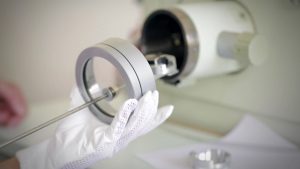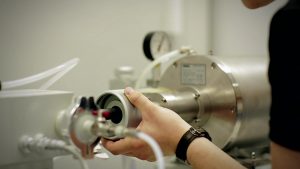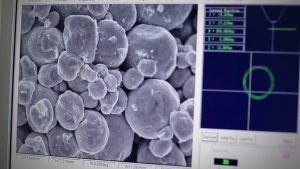Investigations



The offer of R&D works and commercial research services of Łukasiewicz − Krakow Institute of Technology includes investigations on:
- microstructure
- chemical and phase composition
- non-destructive testing
- mechanical properties
- physical properties
- thermophysical properties
- thermodynamic properties
- high-temperature corrosion mechanisms of materials based on iron, nickel and titanium
- high-temperature liquid/solid interaction
We offer a wide range of tests performed by the Accredited Laboratory in the field of accreditation No. AB 197.



What do we test?
- iron alloys: cast iron, cast steel, steel
- cobalt, titanium and nickel alloys
- non-ferrous metal alloys and composites based on them
- ceramic composites
- systems: metal-metal, metal-ceramics, metal-glass, glass-ceramics
- technological and protective coatings
- ceramic slurries, casting waxes, colloidal liquids
- moulding and core sands
- reclaimed sands
- products and materials, including construction ones



Testing methods/techniques:
- investigation of microstructure, chemical and phase composition of materials by scanning electron microscopy with the use of EDS and WDS spectrometers in high and reduced vacuum, allowing for qualitative and quantitative microanalysis of elements from boron (B) to uranium (U) along with the preparation of samples for testing (metallographic cross-sections, chemical etching, thermal etching, Focus Ion Beam)
- investigation of the chemical composition with the μXRF method – determined elements: Sb, Sn, Pd, Ag, Ru, Mo, Nb, Zr, Bi, Pb, Se, W, Zn, Cu, Ni, Co, Fe, Mn, Cr, V, Ti, Al, S, P, Si, In, Cd, Rh, Au, Pt, Ir, Ga
- X-ray structural analysis (XRD): qualitative and quantitative phase analysis, texture measurement, stress analysis, temperature measurements up to 2300°C
- particle size measurements using the DLS method of dry and suspended solids 0.1−2000 μm
- investigations of zeta potential and particle size – measurement of nanoparticle size in the range of 0.6 nm – 6 μm, zeta potential in the range of 5 nm – 10 μm and molecular weight: 1000-2*10^7 Da
- sieve-analysis, pH, loss on ignition LOI, swelling index, lustrous (brilliant) carbon content, volatile matter content
- non-destructive testing of finished elements – CT computed tomography and X-ray radiography, magnetic-particle (MT) and ultrasonic (UT) methods
- testing the dimensional and shape correctness and the quality of the external surface (coarseness, roughness of surface measurement)
- hardness and microhardness measurements using the Brinell, Rockwell, Vickers and Knoop methods
- determination of Young’s modulus by ultrasonic method
- tribological tests, coefficient of friction and wear index using the ball-on-disc method
- knock-out property (breakdown)
- testing the technological properties of moulding sands: permeability, flowability, friability, compactability
- tests of moulding sand strength parameters: bending strength, tensile strength, shear strength, tensile strength in transformation zones (wet tensile strength)
- fatigue strength tests using the rotational bending methodtesting the machinability of materials and the cutting ability of tools, as well as the impact of cutting fluids on these properties
- solderability tests using the immersion method in the temperature range of 20-450°C with flux and/or protective gas
- determination of density, dry substance content, sedimentation, gas evolution rate, adhesion and wear resistance of coatings
- determination of density using the Archimedes method or helium pycnometer
- electrical conductivity tests
- tests of temperature conductivity and determination of thermal conductivity up to 1500°C
- dilatometric tests in the range of 180–2800°C, including optimization of sintering process parameters, determination of sintering temperature, determination of linear expansion of materials, determination of material shrinkage, determination of glass softening point, analysis of endothermic and exothermic processes in the tested materials, c-DTA curves of materials; determination of critical temperatures and transformation heat; construction of CHT, CTPc and CTPi charts
- determination of high-temperature characteristics of liquid metals using the sessile drop method (wettability kinetics, surface tension, reactivity in the liquid/solid system)
- measurements of wettability of solid materials up to 1000°C using the method of spreading drops in the air atmosphere and calculation of the extreme contact angle
- determination of characteristic temperatures of ceramic materials by optical method from room temperature to 1750°C
- pour point tests. determination of the coagulation curve
- tests of resistance to thermal shocks – alternately in the furnace and in water
- thermal imaging tests of the temperature profile (heat emitted)
- shrinkage measurements, deflection arrow tests
- determination of the softening temperature of sands, waxes and the amount of released gases
